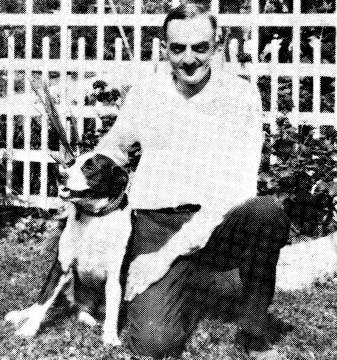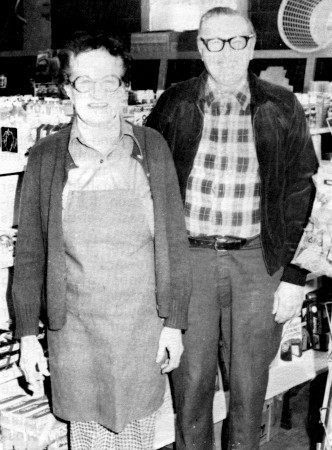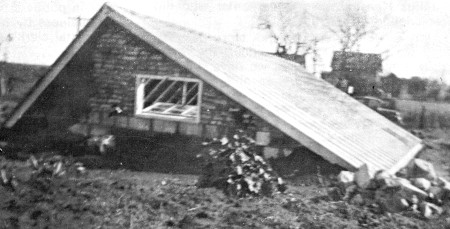

The new brick building was completed in the fall of 1917. This building had a large machine shop to the south and the store and the post office were to the north. This store even had a basement where the local children would be hired to shake potatoes over a grate over the cellar door. The large potatoes would stay on the grate and the smaller ones would fall to the cellar. The larger potatoes would be sacked and then be shipped to train by their destinations. In the fall many of the farmers would bring their potatoes in by horse and wagon to be sold.
This building also had a pump that stood on a wooden platform on the north side where people could purchase kerosene.
Clara Ehrichs, who could speak German, also worked at the store because she could visit with many of the customers in their native tongue.
In 1925, Ben Ehrichs moved away and Frank became partners with William (Bill) Hansen. The implement shop was turned into a cream station and later on even became a feed and poultry business. This store is now called the Ehrichs and Hansen Store. Later when this partnership was also dissolved, Frank ran the business alone, calling it The Farmer's Mercantile.
In 1947, half of the store was again destroyed by fire. The Manning and Manilla Fire Departments were called to assist, but since there were no water hydrants in town and the strong wind was causing havoc, the fire fighters were unable to do much except try to save adjoining buildings. There was a brick partition between the two halves of the building, which saved the machine shop. This was turned into the store and is still used today. Some of our "middle age" guys, who were kids then, confessed to digging in the rubble for the cash register, hoping to find a "million." Instead they found burnt bills and coins that were all melted together!


Page 52
Frank Ehrichs was the owner and operator of the Aspinwall store for 54 years and also the postmaster for 37 years. He was a buyer of hogs and fat cattle, had business interests in the grain market, was an investor in the stock market and even sold insurance!
Many different items have been sold over the counters of the Aspinwall store throughout the years. The store always had to provide the necessities in life, to provide for the changing needs for the local families.
Frank went from selling yard goods and clothes to selling the Philco and Majestic radios. He went from selling horse harnesses and collars to selling refrigerators and other modern appliances. In about 1950, Frank even began to feature that "wonder of all wonders," the TV! Many people would gather at the store in the evenings and watch some favorite program.
The store even handled pianos in the earlier days, and in a "Factory to Home Sale" at the Ehrichs' Brothers Store in December, 1914, the prices were listed from $350 to $550.
Frank will be remembered fondly by those who knew him. He had to put up with a lot of things over the years that the local children would confront him with. It has been said that some of the fellows in town even walked out of the store one night with a TV set, just to see if Frank would miss it. Frank didn't let on that he missed the television, so the fellows shamefacedly returned it and nothing was ever said about the incident.

As far as employees in the store were concerned, we knew very little about the early years. In some of the pictures we have, it looks like one or two individuals were able to handle the flow of customers.
Frank Ehrichs gave many of the young men in the community a chance to work after they graduated from high school or from eighth grade. Among these were Gene Ehrichs, Wallace Schroeder and the Schilling boys, Robert, Roy and Ronald.
Al Henkelman and Betty (Ehrichs Henkelman) Sinow were also employed by her father, Frank Ehrichs, for a while.
Esther Hinners Anthony was probably employed at the store for the longest time.

SCHROEDER'S GROCERY STORE
Wallace Schroeder, the present owner, is interestingly the great-grandson
of Christ Lemster, the man who first purchased the
land from the Milwaukee Railroad. Wallace purchased the store from Frank
Ehrichs in January of 1965. Prior to that time, Wallace had been a school
teacher in Lutheran schools in Missouri and later in public schools in Iowa. He
is assisted in his business by his mother, Marie, who is also the postal clerk
of the post office located in the store.
Wallace and Marie have been true friends to the people in and around Aspinwall over the years. They provide a warm place in the store for the school children who must wait for the school bus on winter mornings, and they always understand the problems and needs of all their Aspinwall customers.
When asked what her early impressions of the "old store" were, Marie thought for a while, got a faraway look in her eyes and finally signed, "The pleasant aroma of the coffee beans being ground. And, oh, how tempting those bananas were as they hung suspended from the store ceiling!"
Page 53
THE ASPINWALL GREENHOUSE
In 1934, John Babik was home on leave from the service when the idea of
building a greenhouse in Aspinwall first entered his mind. John and Erna Uselding, who lived on the same block as the Babiks, had just lost their home to a fire and the lot was
still empty. The young Babik thought it would be a good business opportunity to
purchase the lot and construct a greenhouse directly over the basement of the burned out building.
John had another reason for his business venture: his father, Andrew, was a lover of plants and flowers and very adept at growing "green things." This would give his father something to do after his retirement from the railroad and also bring some extra money into the household.
The greenhouse never really prospered, John remembers, as Andrew gave away more plants than he sold. Ladies from Manning would come to the Aspinwall greenhouse, admire the beautiful plants and flowers, and pick out an armful of assorted items for their "teas." They would ask the fee, and Andrew, feeling content with the compliments, would charge only a $1.
"The greenhouse was a darn good one," John said from his home at Omaha. "If it would have had better management it could have been as good as Earl May's or Henry Field's!"
Andrew continued the business until the early 1940s, when he moved away. The building sat empty for awhile, and after a hail storm hit, the glass-paneled roof was shattered, ending all hopes of reviving the business.
When Herb and Alice Kuhl and their two young sons moved to Aspinwall, they purchased Babik's lot along with the home to the south. The greenhouse was razed sometime in the mid-1940s; people remember a bulldozer plowing the whole thing under, noting that the land today would probably be full of glass.

ODDS AND ENDS
Frank Ehrichs, owner of the Ehrichs grocery store in Aspinwall, became a
partner in the general merchandise store in Manning in 1928 which was then
known as Kleespies Brothers. Frank purchased the entire business in 1930, and
in 1931, the Manning Monitor reported, "Mr. Ehrichs, the proprietor and
manager of the Manning store, is a man of a wide range of experience in the
mercantile business; has this well equipped store in Manning and another large
store in Aspinwall. These two establishments enjoy a splendid trade and a
reputation of competing with other stores in prices and goods."
Specials advertised in the August 20, 1931 edition of the newspaper were good
at both the Manning and Aspinwall stores. Listed were coffee, 25c/pound;
catsup, large bottle, 19c; sweet pickles, quart jar, 33c; parowax,
10c/pound; pork and beans, 3 cans/21c; cake flour, large package, 23c; powdered
sugar, 2 pound package / 22c; marshmallows, 19c/pound; orange slices,
19c/pound; milk, 3 tall cans/21c; spaghetti, 2 cans/19c; pears, no. 2 1/2
can/19c; and red cherries, 19c/can. These specials were good for the entire
week; "extra specials for Friday and Saturday only" were bacon,
19c/pound; smoked picnic ham, 14c/pound; pork shoulders, 12c/pound; and pork roast, 15c/pound.


ASPINWALL HOTELS
Aspinwall had at least two hotels before 1900. One was on the west side of
Main Street just north of the present Aspinwall Tap; the other was across the
street in the vicinity of Schilling's Machine Shop. One of the hotels, the
Aspinwall House, was in operation by 1884; the second had been added within the
next two years, when Aspinwall had a population of around 300. According to an
article in the August 19, 1886 Manning Monitor, both hotels included
refreshment stands, and they were run by M.J. Hanson and John Claussen.
The hotel on the east side of the street burned in a 1901 fire which destroyed all the businesses along that side of the block. The creamery building was moved to that site after 1902, and it too had rooms for rent. Railroad workers boarded at the creamery-turned-store around 1910.
The hotel on the west side of the street was owned by the Johannes (John) Koester family around the turn of the century. Mr. and Mrs. Koester and their five children lived in the west end of the building; their bedrooms were upstairs and cooking facilities for both the family and the boarders were at the rear of the first door. Others could also come to eat there; when William Ewoldt's wife became ill and eventually passed away, William brought his five sons and daughter to eat all their meals there daily.
In addition to hotel facilities, there was a dance floor at the southeast part of the building; the opera house also had a dance floor at this time, giving Aspinwall residents two choices for a night of dancing. From accounts we've heard, the dances were quite popular and well-attended, with merrymakers often staying until 3 or 4 a.m.
The Koester family moved to Sac County about 1906; the hotel and home were destroyed in a fire. By 1910, there was no sign of the structure, and Emil Ehrichs built his first garage there in 1914.
Also on the west side of the street, to the north of the hotel, was a livery barn built by Henry Kuhl in 1898. The barn was reported to be a great benefit for farmers who came to Aspinwall on business. In later years, after the hotel burned, the big red livery barn was moved to the acreage a half-mile south of Aspinwall, where it was used as a barn. John Uselding was convicted of arson in the September 23, 1932, fire which destroyed the barn, home, and other buildings at the acreage.